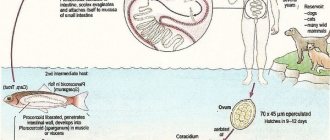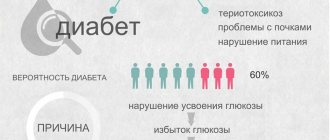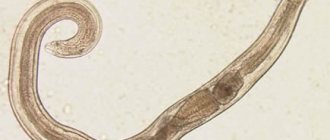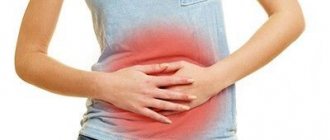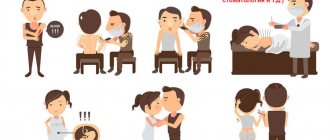- A little about helminthiasis
- Life cycle of helminth
- How is the infection transmitted?
- Effect of the parasite on human health
- Symptoms
- Diagnostics
- Treatment
- ethnoscience
- Complications
- Hookworm infection in animals (cats, dogs)
- Prevention
Hookworm disease is a disease of the group of nematodes, which is characterized by damage to the gastrointestinal tract and the development of persistent iron deficiency anemia. Most often, helminthiasis is diagnosed in areas of high humidity, for example, the countries of South America, Africa and Asia.
A little about helminthiasis
The causative agent of the disease is hookworm duodenal or hookworm. The parasite is a geohelminth, a group of roundworms that parasitize the human intestinal tract.
Like the vast majority of nematodes, worms are dioecious. Females have a length of 1 to 1.5 cm, males - from 5 to 10 mm. Parasites are colored reddish. The head of the hookworm has a mouthparts with several teeth. With its help, it injures the intestinal mucosa, violating its integrity, and releases a substance - an anticoagulant, which prevents blood clotting. It is this biological fluid that is the main food for hookworms. An adult eats from 0.1 to 0.3 ml of blood per day.
The helminth does not stay in one place. It constantly migrates through the tissues of the intestinal tract, creating bleeding wounds across its entire surface. A similar process results in the development of anemia, general weakness, headaches and diarrhea for a person.
There are several types of hookworms that are common in humans and animals. Let's look at this variety in the following table.
| Type of helminth (host) | Geography of the disease |
| ANCYLOSTOMA DUODENALE (Human) | China, Middle East, Africa |
| ANCYLOSTOMA CEYLANICUM (Dog, cat) | India, Asia, Philippines |
| ANCYLOSTOMA CANINUM (Dog, human) | Everywhere |
| ANCYLOSTOMA TUBAEFORME (Cat) | Everywhere |
Causes
The causative agents of hookworms are the roundworms of the hookworm species Ancylostoma duodenale (also called hookworms) and the necator Necator americanus. They are pale pinkish in color and small in size - up to 18 mm, females are somewhat larger. Hookworms have cuticular teeth in their oral capsules, while necatoras have cutting plates with which they are able to attach to the intestinal walls.
Appearance and development of hookworm larvae
Females of the family Ancylostomatidae are capable of releasing up to 15 thousand eggs per day, consisting of 2-4 blastomeres.
Life cycle of helminth
The definitive host of hookworm is humans. His parasite lives in the duodenum. Worm eggs are excreted from the body in feces. Once in the soil, they hatch into larvae that have invasive properties.
The presence of parasites in the ground is an indispensable condition in the life cycle of hookworm, as with all representatives of geohelminths. But development requires certain environmental conditions, namely optimal humidity, aeration and a temperature Celsius of at least 27 degrees. For this reason, the spread of hookworms is limited to individual habitat areas.
The larvae remain viable in the soil for up to 18 months. During this period of time, they have to penetrate the human body in order to reach maturity and begin the process of reproduction.
Infection occurs in two ways:
- THE FIRST METHOD is percutaneous. The larva penetrates the skin and, together with the systemic bloodstream, ends up in the human lungs. Then through the trachea it enters the nasopharynx and is swallowed into the digestive tract. Once in the small intestine, the hookworm penetrates the mucosa and reaches maturity. After 6 months, female helminths begin to actively lay eggs.
- THE SECOND METHOD is oral. That is, a person simply swallows a larva from the environment. In this case, the parasite immediately appears in the intestine, invades its tissues and reaches sexual maturity. With the oral method of infection, nematodes begin to lay offspring within 5 weeks after introduction.
At this point, the life cycle of the hookworm repeats. The eggs of the parasite appear as oval formations with a barely visible shell when viewed under a microscope. Female helminths have a well-developed ability to reproduce offspring - each of them lays from 6 to 55 thousand future parasites per day.
General information
Hookworm disease belongs to the group of helminthiases .
As anthroponotic parasites of the family Ancylostomatidae, hookworms and necators are able to exist under normal natural conditions only in human organisms; invasion occurs orally (through the mouth) and percutaneously (through the skin). The disease is widespread in countries with subtropical and tropical climates (South and Central America, Africa, Hindustan, Indochina); according to WHO statistics, 25% of the world's population is infected. In areas with moderate climatic conditions (Caucasus, Turkmenistan, Kyrgyzstan), gardeners and people working underground, in mines where there is high humidity and temperature, are at risk.
How is the infection transmitted?
Helminthiasis is spread by hookworm eggs, which end up in the external environment with human feces. Under optimal conditions, it will take only a week for the larva to emerge. Then the future nematodes climb up the plants, above ground level. After this, they penetrate the skin of a person’s legs and feet upon contact.
Less commonly, larvae enter the intestines of people with poorly washed vegetables.
It is also known that hookworm is able to cross the placenta and infect the fetus in the body of a pregnant woman in utero.
How to get rid of hookworm?
Modern medicines will help expel helminths in a short time:
| Albendazole | A universal drug that helps with many types of parasite infestations, it is effective, safe and inexpensive. The course of deworming is from 1 to 3 days. |
| Levamisole | An effective drug, it has a large number of contraindications, the course of treatment is 1 day. |
| Pirantel | Effective and safe, used to treat children and pregnant women. The course of deworming is from 1 to 3 days. |
| Mebendazole | It is most often used to expel necator. The course of treatment is from 1 to 3 days. |
The effectiveness of treatment is monitored by studying the results of the coprogram. If there are hookworm eggs in the stool, the course of treatment is repeated. Additionally, anemia is treated with iron supplements and folic acid.
Effect of the parasite on human health
Infection through the percutaneous route causes more negative changes in the body of the infected person compared to the oral route of transmission of the disease. This is due to the long process of migration of larvae.
In the place where the parasites have penetrated the skin, dermatitis-type irritation develops.
It resembles the bite of a blood-sucking insect. The inflammatory process is caused by massive release of histamine by mast cells, increased vascular permeability and local changes in the dermis.
Larvae that enter the lungs cause Leffer's syndrome. It occurs with a cough characteristic of bronchitis and the formation of infiltrates in the lung tissue. This syndrome is the result of an allergic reaction of the body to the introduction and waste products of nematodes. The pathology is manifested by eosinophilia and inflammation of the respiratory system.
Due to adult hookworms feeding on human blood in the duodenum, the patient eventually develops persistent iron deficiency anemia or anemia of unknown origin. Every day a person loses up to 0.3 ml of blood from the vital activity of each helminth. The more intense the disease, the more pronounced the anemia in infected individuals.
The mechanical penetration of hookworms into the intestinal wall triggers complex neuro-reflex reactions activated in the abdominal cavity. It should be noted that parasites are extremely mobile. They attach to the intestinal mucosa for about a couple of minutes, after which they change their location. Injuries to the digestive organ do not go away without leaving a trace. Often the disease is supplemented by the addition of a secondary infection, the development of tissue hyperplasia with possible malignancy - the formation of a malignant process in the gastrointestinal tract.
Preventive actions
Prevention of hookworm disease is individual. It primarily concerns travelers and people living in endemic areas.
Main events:
- Refusal to eat poorly washed vegetables, fruits, and herbs. It is advisable to remove the peel from them before use.
- Refusal to eat in unfamiliar places, on the street, or eat foods with “local flavor.”
- Wear shoes, avoid walking barefoot and lying on the grass. It takes 5-10 minutes for infection to occur.
- After visiting endemic countries and areas, you need to monitor your well-being and the health of family members. If the above-described symptoms of allergosis, gastrointestinal disorders, or damage to the respiratory system occur, you should consult an infectious disease specialist for examination and laboratory tests.
- Prophylactic administration of anthelmintic drugs is usually not carried out.
Symptoms
The incubation period averages 8 weeks. During this time, a person infected with hookworms does not notice any changes in his health. Only at the site where the parasite penetrates the skin does inflammation, itching and slight swelling appear.
The disease itself consists of two phases - migratory and chronic. Let's take a closer look at them.
Migration phase
Once the larvae enter the human body, they begin active activity, causing serious allergic reactions in the person. Infected individuals notice rashes on the skin, swelling and itching, which are located everywhere, and not just in the area of penetration of the helminth.
Additionally, a cough of a paroxysmal nature appears, with copious sputum and streaks of blood, and pneumonia rarely develops. A person complains of an increase in body temperature up to 40 degrees, weakness and aching muscles, headache, and sometimes symptoms of suffocation. If you take an x-ray at this moment, you can see eosinophilic foci of inflammation in the lung tissue.
Chronic phase
After adult hookworms colonize the intestines and begin intensive reproduction, the second stage of the disease begins. A person has complaints about disruption of the digestive system, namely pain in the umbilical ring, flatulence, frequent bouts of diarrhea, lack of appetite and periodic vomiting.
Iron deficiency anemia is diagnosed in 100% of patients. Additionally, there are signs of hypotension, tachycardia, peripheral edema, tinnitus and increased weakness. The nervous system also suffers from helminthiasis: patients experience excessive irritability and insomnia. In women, hookworm almost always leads to menstrual irregularities. ECG often reveals myocardial dystrophy. Blood tests showed a persistent decrease in hemoglobin, red blood cells and albumin.
If diagnosis and treatment are not available at this stage, the patient's condition continues to deteriorate.
A person is diagnosed with the following symptoms:
- dyspnea;
- brittleness of hair and nails;
- dry skin;
- swelling of the legs and anterior abdominal wall;
- pain in the stomach associated with hidden bleeding (pseudoulcer syndrome).
If there are few parasites in the body, the disease remains latent for a long time. Only an increased level of eosinophils in the blood can tell a specialist about its presence.
Diagnostics
The disease is determined according to the criteria specified in the table.
| Research methods | Pursued goals |
| ANAMNESIS | The specialist identifies the fact of the patient’s contact with soil and feces (peculiarities of the profession, treatment of cesspools, etc.). |
| INSPECTION | Clinical symptoms of the disease are identified and compared with the picture of hookworm infection. |
| BLOOD ANALYSIS | The level of eosinophils and hemoglobin, as well as other indicators, is studied - in this pathology their number is reduced. |
| RADIOGRAPHY | Changes in the pulmonary pattern, decreased intestinal motility, and stagnation of its contents are determined. |
| SCATOLOGY | Feces are examined for helminth eggs. Unfortunately, this type of diagnosis cannot determine with a high probability the exact type of parasite. |
| MACROSCOPY | An adult specimen removed from the human body is being studied. This method is used after deworming. |
Based on the diagnostic work performed, the specialist selects the necessary therapeutic effect.
Treatment
The fight against the disease is aimed at:
- Destruction of hookworms in the patient’s body.
- Elimination of the consequences of helminthiasis.
The first problem is solved by selecting medications that have antiparasitic properties. Treatment is carried out under mandatory monitoring of the patient’s blood picture due to the high risk of developing undesirable effects. Inpatient observation is not required for patients. To combat hookworm, the following are usually prescribed:
- PIRANTEL. The dosage depends on the patient's body weight. Course 3 days;
- LEVAMISOL. Adults take 150 mg of the drug once, children - based on age and weight;
- MEBENDAZOLE. The amount of medicine is selected by the attending physician. Course 3 days.
Less commonly, pathology is eliminated with the help of other anthelmintics, depending on the recommendations of a specialist, the presence of contraindications and the patient’s medical history.
After the destruction of parasites, the elimination of the consequences caused by their presence in the human body begins. It is recommended to carry out symptomatic therapy aimed at restoring impaired functions and health indicators. These include:
- elimination of anemia - taking B vitamins, ascorbic acid and iron supplements;
- treatment of allergies - prescribing antihistamines and hormonal drugs;
- fight against inflammatory reactions and infectious processes in places where hookworms are introduced - selection of antibiotics in the form of ointments, tablets or injections.
Separately, changes in a person’s diet should be considered. To restore impaired indicators and replenish the lost supply of energy resources, it is recommended to review the diet. It should include a sufficient amount of animal and vegetable protein (meat, fish, legumes) and complex carbohydrates (cereals and vegetables).
It should be noted that hookworm infection in children in an advanced, untreated form leads to retardation in physical and intellectual development, and in adults it leads to exhaustion. That is why timely contact with a specialist is the most important aspect of maintaining overall health.
Signs of hookworm disease
The first signs of hookworm disease are the reaction of the skin, usually on the feet and legs, to the introduction of larvae. After itching and burning, swelling, redness and bumps appear. When an infection occurs, blisters with liquid, ulcers, and crusts appear. Eczema lasts a long time.
| Photo. Reaction of the skin on the foot when larvae invade. | ||||||
| 1 day | Day 2 | Day 3 | 4 day | 5 day | Day 6 | Day 7 |
During the migration of larvae, eosinophils, cough, bronchitis, and unstable infiltrates in the lungs are increased.
1-2 months after the appearance of dermatosis, the intestinal form of the parasite makes itself felt. Patients complain of dizziness, weakness, shortness of breath, pain and heaviness in the abdomen, diarrhea, constipation, and perversion of appetite. Taste perversions and a feeling of “ravenous hunger” can lead to the absorption of special varieties of edible clay. Constipation alternates with diarrhea, mucus and blood are found in the stool, sometimes the stool has the character of “chernukha” (melena). In women, menstruation is delayed or disappears altogether. In mild cases, anemia is determined only by a blood test. In severe cases, patients experience puffiness with a waxy coloration of the face, pallor of the mucous lips, conjunctiva, sclera, ears, fingers, palms of the hands, spoon-shaped nails, i.e., all signs of hypochromic anemia. If left untreated, swelling of the subcutaneous tissue and ascites appear. With prolonged anemia, myocardial degeneration occurs, a systolic murmur appears in the heart, and the electrocardiogram changes. In children, there is a lag in physical and mental development, in adults there is decreased ability to work, depression, drowsiness, grumpiness, and increased sexual excitability.
Video. Crooked head in the intestines
Male, 37 years old. Complaints of anemia and bloody diarrhea. He underwent 10 blood transfusions. There are many crooked heads in the duodenum. / Male, 46 years old. Complaints of abdominal pain and fatigue - 6 months. Pale, hemoglobin 80 g/l. The crooked head sucks blood in the intestine.
ethnoscience
This treatment option may not have a complete effect on hookworm. But alternative medicine improves the effects of medications and speeds up the patient’s recovery.
For example, a decoction of rowan berries, currants, nettles or dried apricots can normalize the amount of hemoglobin in the body. These folk recipes eliminate anemia without the use of radical therapeutic methods in the form of blood transfusions.
In addition, traditional medicine offers garlic tincture to combat hookworms. Pour 5 large heads of garlic into a bottle of vodka, keep the product for 10 days in a tightly closed container in a dark place. The finished drug is taken on an empty stomach, 1 tablespoon in the morning and evening immediately before meals.
Hookworm infection in animals (cats, dogs)
Quite often, cats and dogs become infected with nematodes. Infection of animals can occur through the skin, placenta, mother's milk and the fecal-oral route.
If a cat eats food or drinks water with hookworm larvae, they easily penetrate the small intestine and develop into adults. The process usually takes 21 days. Just like in humans, parasites in animals feed on blood. Helminth eggs are released into the environment with feces. The disease is dangerous due to the development of anemia and general toxic damage to the body.
The following symptoms will help determine hookworm infection in cats:
- decreased appetite;
- depressed state;
- dull coat;
- blood in stool;
- inflammation of the paw pads.
After diagnosing the disease, the animal must be treated. Usually it is limited to a single dose of drugs such as Pyrantel, Praziquantel or Mebenvet granulate. The dosage of the medication depends on the weight of the cat.
Additionally, the animal is prescribed supplements such as Ferrum Lek, injections of folic acid and B vitamins. With the help of these medications, the functioning of the hematopoietic system and the number of red blood cells in the body are normalized.
Hookworm infection in dogs also causes severe intestinal damage. Most often, invasion occurs through the fecal-oral route. Less commonly, parasite larvae enter the animal through breaks in the skin, causing urticaria and anemia.
As a result, the dog loses interest in its surroundings, becomes lethargic, refuses food and dies without timely help. The symptoms listed above and laboratory analysis of stool help to diagnose the pathology.
Treatment of hookworm in dogs is carried out with the drugs Tenium and Naftamon. They are offered to the animal along with food. Additionally, veterinarians recommend how to treat anemia in a pet using iron-containing medications.
Diagnostic methods and their information content
To establish a diagnosis of hookworm or necatoriasis, the patient will be recommended a number of instrumental and laboratory tests:
- OAC are signs of iron deficiency anemia of varying severity (hypochromic, with a small size of red blood cells and a decrease in the color index, a decrease in serum iron and an increase in CVS). The severity of anemia directly depends on the duration of the disease and the number of helminths in the small intestine.
- OAM is not very informative.
- Biochemical blood test - a decrease in the level of total protein mainly due to albumin.
- A standard stool test for helminth eggs can detect hookworm and necator eggs, which look exactly the same under microscopy. To increase the sensitivity of the method, it is recommended to perform the study 3 times with an interval of 7-10 days. The use of concentration methods (flotation, etc.) further increases the information content of the analysis. The characteristics of hookworm eggs include the following characteristics: 1) identical in the two described hookworm species; 2) they have an oval or elliptical shape; 3) colorless; 4) float on the surface in a saturated solution of sodium chloride; 5) non-infectious after exiting the intestines; 6) have free space between the shell and the contents; 7) dimensions: 55-75 by 35-40 microns.
- Cultivation of larvae using filter paper using the Harada-Mori method.
- Microscopy of duodenal contents obtained during FGDS.
Figure 5 - Morphology of hookworm eggs
Prevention
To avoid hookworm infection, the following measures are recommended:
- rules of personal hygiene - timely washing of hands after visiting the toilet, contact with animals and soil;
- thorough cleansing of vegetables and fruits;
- drinking quality water;
- avoiding walking on the ground with bare feet.
Most often, timely diagnosis and treatment result in complete recovery. Medical examination of persons who have had hookworm infection in humans is carried out annually for 4 years. Anyone who is at high risk for the incidence of this helminthiasis should undergo regular medical examination in medical institutions.
